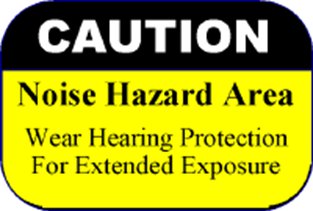 Hearing protection programs are designed to reduce the risk of long-term damage from repeated or prolonged exposure to noises. OSHA standards require a hearing protection program when workers are exposed to noise levels above 85 decibels (dB) based on an eight hour time-weight average (TWA). The TWA is a method of calculating the danger based on the intensity of the noise and the duration of exposure, e.g., the louder the noise, the shorter exposure is permitted.
Hearing protection programs are designed to reduce the risk of long-term damage from repeated or prolonged exposure to noises. OSHA standards require a hearing protection program when workers are exposed to noise levels above 85 decibels (dB) based on an eight hour time-weight average (TWA). The TWA is a method of calculating the danger based on the intensity of the noise and the duration of exposure, e.g., the louder the noise, the shorter exposure is permitted.
The hearing conservation program can take many forms, including medical evaluations and periodic audiograms for employees, safety equipment, reduction in noise levels by absorption or dissipation, training of employees, and posting of warning signs identifying noise hazard areas. As a general rule, most animal hospitals can maintain a very effective program with a minimum of time and resource expenditures.
Until recently, the design of most animal hospitals was such that noise from the kennels was isolated and contained to create a more pleasant environment in the rest of the hospital. Although this can be accomplished, it presents a particularly hazardous environment for workers who must clean the cages and care for the animals.
Noise hazards can exist outdoors
Outdoor runs generally do not have the echo or "bounce" of sound waves common to an indoor area, but they still can be a noise hazard area.
Although it will vary from one breed to another, as well as one animal to another, noise level from a barking dog can reach 80-90 decibels. It doesn't take much of a chorus of barking dogs to exceed the threshold limit for a noise hazard area.
As a matter of fact, noise levels in the kennels typically range from 95 to 115 decibels measured at the center of the room. At the upper end of this range a person could work approximately 15 minutes in the area without hearing protection during an average 8 hour work day.
Noise from dryers and clippers in a grooming room can also present a hazard. Depending on the size of the room, the number of dryers and clippers in use, and the texture of the walls, noise levels can get up to 100 decibels.
The most obvious advice for these two areas is to reduce the noise levels first. Sometimes this can be accomplished by the addition of sound absorbing panels, or "baffles."
If the noise levels cannot be reduced below the threshold limit by architectural or engineering means, then personal hearing protection is required for workers.
Ear plugs are not edible
There are literally hundreds of varieties of ear plugs and phones available. Choose one that is rated to reduce noise levels by at least 20 decibels. Disposable, foam rubber ear plugs are the most common, and are relatively inexpensive. Keep these ear plugs away from animals since they are easily swallowed.
Noise hazard areas must be identified by means of a poster, placard or sign. The wording should reflect the degree of danger. Typically, a sign stating "Warning: Noise Hazard Area. Hearing protection required for prolonged exposure" is sufficient for most areas. Place the sign at all entrances to the areas, including exterior doors. Economical, durable signs made of aluminum, acrylic, or self-adhesive vinyl are available from catalog sources and local safety supply outlets.
In the end, it is still the leadership’s responsibility to enforce the hearing protection rules and OSHA will hold the employer accountable in an inspection.









